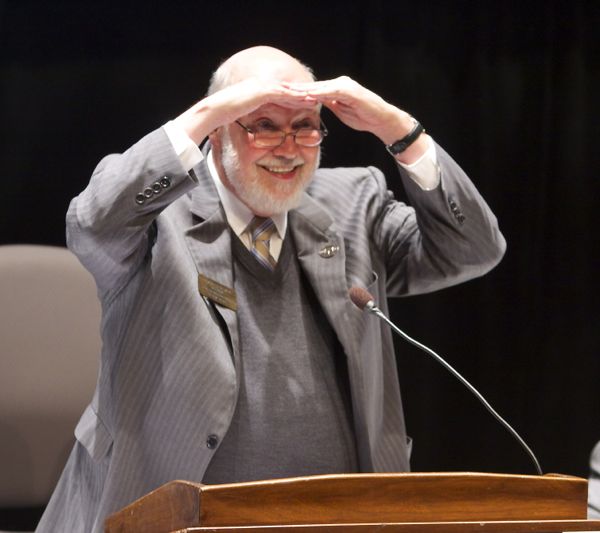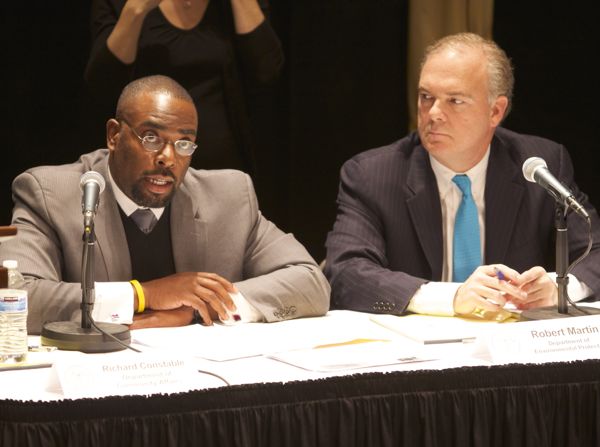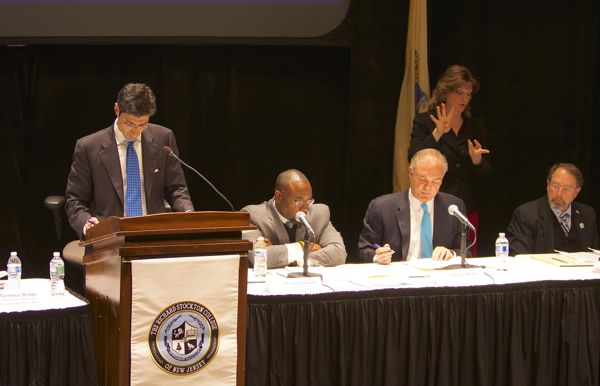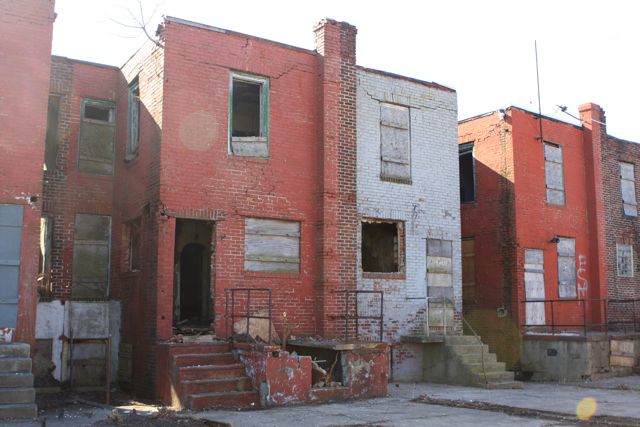The Public Reduced To Spectators At Christie “Mobile Cabinet” Performance on Sandy Recovery
[Update: 2/13/14– Haha! Got a soundbite on the Tee Vee (along with the ass kicking south jersey folks – watch NBC News coverage: Sandy victims speak out at state hearing – end update].
It was tragedy, comedy, and farce all rolled into one big show, as the Christie Administration literally appeared on stage at Stockton College’s Performing Arts Center last night.
What was supposed to have been a public hearing for the Administration to listen to public comments on Governor Christie’s proposed plan for $1.46 billion in round 2 federal Sandy recovery money, turned into a poorly scripted 1 hour long “performance” – in 9 acts, one for each member of Christie’s Team.
The performance was led by Gov. Christie’s Sandy Czar, Marc Ferzan – remarkably just his third public appearance.
Ferzan led a Cabinet that has refused to appear – multiple times – before Legislative oversight hearings, prompting Senate leaders to threaten a subpoena to compel their appearance.
The arrogance was stunning. And I called Ferzan and Friends on that during the hearing.
In contrast, the dozens of people among the 125 or so who turned out for the public hearing and signed up to speak were limited to just 3 minutes to tell their tales of woe with the remarkable and unconscionable mismanagement of the recovery program thus far.
I’m getting ahead of myself, so let me start from the beginning.
I arrived 30 minutes early, expecting hassles on signing up to testify. Sure enough, my prior electronic registration was somehow lost. I was not the only one whose pre-registration didn’t register. If they can’t get something simple like an online registration process right, how can they get something complex like Sandy recovery right?
After manually registering to speak (#9 on the list), I also signed in as press corps because I wanted to get some photos. Surprisingly, there was no hassle about getting press credentials. As press, I not only got a close up spot to take photos, I got the 2 inch think press packet in the pretty yellow folder! Nice touch.
But, right off the bat, I noticed something was really wrong.
The VIP reserved section was empty – where were the shore Mayors, County Freeholders, and State legislators?
Why were they no shows? Why didn’t they appear to listen to the problems their constituents are experiencing? To find out how badly state programs they oversee are working?
As the event began, an administrator from Stockton welcomed the public – but he might as well have shouted:
Hello out there to you spectators sitting in the dark! Can you see me? Because I sure as hell can’t see you!

Stockton State representative welcomed the public, but he could not see the spectators in the audience.
It was all down hill from there.
The Christie team stuck to the talking points. They stressed huge multi-billion unmet needs (but they’ve actually distributed less than 25% of the $1.86 billion money HUD granted in round 1, so its not a shortage of money that is causing problems).
They implied that HUD under-funded NJ compared to NY, and blamed almost all the numerous problems on bureaucratic red tape and the need to comply with federal regulations. But a state consultant designed the NJ Sandy recovery programs and State agencies bid the contracts, failed to require adequate staff and training, and oversaw the poor performance of the contractors.
The DEP remarks were canned – I’d heard them delivered several times already – no new info.
But curiously, Mike Winka of BPU went out of his way to explain, at length, why the Administration distributed Hazard Mitigation Grant funds in a way that doesn’t appear to make much sense (see this post: Documents Show That Gov. Christie’s Office Was Involved in Distribution of Sandy Hazard Mitigation Grants to Towns).
After sitting patiently listening – for an hour – to one Christie Cabinet member after the other speak from prepared text, people who had pre-registered to speak were allowed to speak for 3 minutes.
The Christie stage team made damn sure each speaker was aware of the dwindling seconds, as a huge screen clock counted down the short 3 minute interval – a brief and strange interlude indeed.
People spoke of being treated like criminals. Treated with no compassion at all, as if they were trying to get something for nothing. Of getting bureaucratic runarounds for weeks and months on end, as their applications were shunted from private consultant to consultant. About phone calls not returned. Or applications denied for no reason or the wrong reason.
People spoke about being asked foolish and absurd questions – e.g. senior citizens who had lived in their homes for decades were required to prove they were homeowners.

Christie Department of CommunityAffairs Commissioner Constable (L) speaks as DEP Commissioner Martin looks skeptical. DCA got blasted by public criticism, while DEP escaped virtually unscathed, with the exception of testimony by Jeff Tittel and myself.
People who had their homes washed away were required to get asbestos inspections and demonstrate that their homes were not located in environmentally sensitive areas, despite the fact that the homes were gone!
One man made mention of the fact that while he was required to file lots of paperwork, reconstruction of major infrastructure like the $250 million Rt. 35 reconstruction project were granted a categorical exclusion from federal NEPA regarding environmental impact reviews.
Advocate for low and moderate income homeowners and renters blasted the fact that they had to sue the administration to get basic data. They noted that even the complex regulations that governed the various funding programs were kept secret.
One woman spoke of how she diligently paid her flood insurance for many years. But, after her house was swept away by Sandy storm surge, her private flood insurance company denied her claim – get this – on the basis that it was not floodwaters that destroyed her house, but “subsurface migration”!! The ground was literally washed away.
She said the company (forgot name!) should be ashamed – but so should Christie administration regulators who fail to enforce consumer protection and insurance laws.
On top of all that, the control freaks in Christie central had some minion stand next to you and hold the microphone – there was no place to stand and testify. No podium. No central focus where people could look and listen to you. Minions worked the audience like a Phil Donahue show.
That minion holding the mike contributed to the big clock to intimidate people and make for a very undignified public hearing setting.
The voices from the dark audience, their faces unseen but their testimony virtually screaming out about bureaucratic abuse and incompetence, was like a Kafkaesque theater of the absurd.
All in all, not a good night for Sandy victims and victims of future storms that are certain to strike NJ’s highly vulnerable and over-developed coast.
Let’s hope they do better tonight in Newark.








